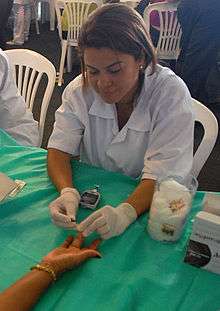Fingerstick
In medicine, some blood tests are conducted on venous blood obtained by fingerstick (or fingerprick) (or, for neonates, by an analogous heelprick). The site, free of surface arterial flow, where the blood is to be collected is sterilized with a topical germicide, and the skin pierced with a sterile lancet.[1] After a droplet has formed, venous blood is captured in a capillary tube (usually relying on surface tension).

Blood glucose monitoring
Tests commonly conducted on the capillary blood collected are:
- Glucose levels – Diabetics often have a portable blood meter to check on their blood sugar.
- Mononucleosis – Fingerstick testing can be used to test for mononucleosis.
- Hemoglobin levels – Fingerstick testing of hemoglobin is a quick screening procedure to ensure a blood or plasma donor has an acceptably high blood count for donating blood or blood components.
- Genetic testing – Heelprick testing of a newborn's DNA allows for early diagnosis and mitigation of common hereditary disorders.
- CBC
- Prothrombin time[2]
Fingersticks are routine for hardy adults, but are generally performed on children and the elderly only if a small amount of blood suffices for needed tests. Neonates are given heelpricks instead, as this is less likely to cause permanent damage.
References
- ↑ Centers for Disease Control, Capillary blood sampling protocol (PDF)
- ↑ Ansell, J.; Holden, A.; Knapic, N. (November 1989). "Patient Self-Management of Oral Anticoagulation Guided by Capillary (Fingerstick) Whole Blood Prothrombin Time". Arch Intern Med. American Medical Association. 149 (11): 2509–2511. doi:10.1001/archinte.1989.00390110085018.
External links
- Heelpricks, section "Blood collection on babies"
This article is issued from Wikipedia - version of the 6/9/2016. The text is available under the Creative Commons Attribution/Share Alike but additional terms may apply for the media files.